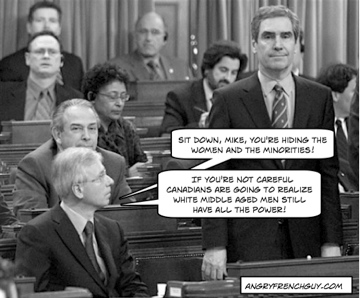Québec Minorities in the 2008 Election: Not So Bloc And White

Ok, I know I’m going to get in trouble for this, but today we are going to look at the color and ethnicity of the Québec candidates in the 2008 federal election in Canada.
Yeah, I know…
I’m sorry but I know you’ve all been doing it too. Diversity is the 21st century litmus test communities, corporations and political parties are judged on. We all scan our products and teams to make sure they reflect the rainbow coalition that proves we are on the good side of the fight.
You know you’ve been walking around Montreal looking at Desjardins’ new ad campaign where they change the name of the company for your last name, secretly keeping count of how many English and « ethnic » names are used. We’ve all been doing it.
Diversity has become a fundamental value of our society. When the Montreal Canadien traded with Edmonton for Georges Laraque, I’m sorry, but my friends were not calling me to discuss the Habs strengthened defense. « We got a black guy! » was the big news.
We value this diversity, but it’s a fluid morphing thing that we are never sure how to define. Your Italian last name might have earned your grand-father a membership card to the « cultural communities » club, but in the age of Tiger Woods and Barak Obama, you’re just another white guy. Names don’t say much. Just think of all the Peter McLeods and Normand Brathwaite’s of Québec who are as pea soup as Jean Chrétien. The candidates bios, although many emphasize it, don’t always tell us much about the candidates heritage. And then, some candidate’s names tell a very different story than their face.
Nevertheless, by using the very arbitrary criteria of VISIBLE minority, the AngryFrenchMediaLabs have determined that the Liberals have the most diverse team with 11 visible minority candidates, the Bloc québécois is second with 8 and the Conservatives and, surprisingly, the NDP, are tied with 6 each.
Two phenomenon have emerged from this politically incorrect exercise: First, the political parties still pad up their diversity cred by dumping minorities in unwinnable ridings. Second, 2008 has seen the rise of a new political operative, the Minority WingWoman.
The Bloc
It seems Gilles Duceppe doesn’t go anywhere these days without his Wingwoman, Vivian Barbot, by his side. She sits behind him in the House of Commons, her face is as big as his on the campaign bus and she follows him around wherever he goes in Montreal.
Gilles Duceppe and the Bloc have worked harder than anyone to bring the sovereignty message to Montreal’s cultural communities and in 2008 these communities’ representation in the sovereigntist team is about proportional to their weight in Québec at large. Most of them, with the exception of Ève-Mary Thaï Thi Lac in the more rural riding of Ste-Hyacinthe-Bagot, face extremely tough fights in central Montreal neighborhoods and even incumbents like Mme Barbot are far from certain they will have a job on september 14th.
The Liberals
Way before it was fashionable, the Liberal Party of Canada was branding itself as the party of multiculturalism and it’s head start holds strong with 11 visible minority candidates. Leader Stéphane Dion has even been campaigning in the ROC as the son of an immigrant himself – his mother is from France – for whom English is a second language.
Most minority candidates are running in unwinnable ridings in Montreal, Laval and the South Shore. It is not impossible that Marlene Jennings, Stéphane Dion’s answer to Vivian Barbot, will be the only one elected.
The Liberals do still have the unconditional support of Anglophones and third and fourth generation Italian, Portuguese, Greek and Jewish communities who will probably elect at least another half-dozen invisible minorities to Parliament.
The NDP
Jack Layton has a natural visible minority WingWoman, his real-life wife and fellow MP Olivia Chow.
That said, it is surprising how few minorities are running for the only Canadian party that’s a charter member of the Socialist International. The AngryFrenchGuy counted only six. (A few names were not counted as the website offered no bio or picture of the candidate.)
The NPD and Jack Layton have a tremendous amount of sympathy in Québec, but those people usually vote Bloc québécois when it counts. The only chance the NDP have at a seat is in Outremont and Westmount-Ville-Marie if, and only if their candidates Thomas Mulcair and Anne Lagacé-Dowson, convince all the Bloc voters to vote for them.
That’s right, the NDP’s only chance in Québec is getting sovereigntists to elect two Anglophone left-wingers in two of Canada’s wealthiest ridings. The workers revolution…
The Conservatives
Unlike Gilles Duceppe and Stéphane Dion, Stephen Harper does not have a black woman sitting behind him in Parliament. There are few women in the Conservative caucus to start with.
With the exception of the Bloc, the Conservatives probably have the worst image problem when it comes to diversity and, as far as Québec is concerned, it’s not their handful of candidates in lost-in-advance ridings that will change anything about it this year. The most notorious Conservative minority in Québec is Mustaque Sarker who got headlines for running in a French neighborhood while barely able to speak French himself.
The Conservatives do, however, once again demonstrate their uncanny knack in appealing to forgotten constituencies, as evidenced by the high number of rural Québec Anglos running for them.